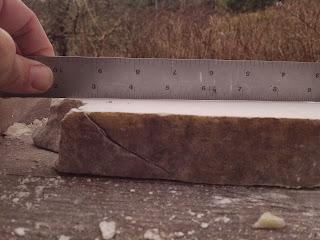Too hard to be gypsum.. Calcite? Metaquartzite? I splashed a bit of vinegar to check for efflorescence and while the stone itself didn't fizz, the dust from grinding DID fizz. DING! I think that we have a winner!
Amblygonite. Phosphate group, mohs' 5.5-6, short prismatic triclinic crystals, cleavable white/grayish masses, translucent vitreous lustre. Soluble (with difficulty) in acids. I can't find any reference to it's efficacy as a sharpening stone, go figure.
Here is how I make a natural waterstone. Well, not MAKE the stone, but you get the idea. I suppose that this is all a ridiculous amount of work for a sharpening stone that will probably be mediocre, at best, but I enjoy it and they do look neat. I like the irony of using what is obviously a ROCK to make my tools insanely sharp.
This is the rough surface of yesterday's stone. Kind of sandy, but actually very small crystals. Not sandstone or quartz, though.
Cleaves along defined planes. This makes things MUCH easier.
Roughly flattened using a diamond cut-off wheel on a hand grinder. I should have asked for a diamond cup-wheel for Christmas. Maybe next year...
If I want to save myself some work, I get within about .5mm using the power tools.

These would make things a lot easier. A 4 inch diamond cup wheel and an 8 inch lapping plate...... Oh yeah...
I wet the work surface, then use it as a flat reference plate. Sort-of flat.... flattish.
Bring out the diamonds! I took a few swipes, then decided that it was still too early, so....
Living at the beach means that you have an unlimited supply of abrasive media. I think that the pine needles and wood shavings help too.
A splash of water, a pinch of sand, and a block of basalt. Stone age lapping technique. This goes faster than you might think. Way faster than using the diamond plate, strangely enough. Unless the stone is REALLY hard. Making the basalt block took.... a while. Maybe 1 hour/face...I could do it faster now that I've gotten so much practice, hehe.
NOW it's time for diamonds. No question about the slurry color (it's white).
1200 grit will leave a decent, reflective, polished surface.
And a new, strange, sharpening stone. Average size is 220-100-28 mm. I wonder if it will work?
My old scraper blade, not really sharp. Old Akio Tasai? I think that I've seen these markings somewhere....
Lots of black slurry using ODC#2 nagura. The ODC is soft, like chalk, and I only give the stone a few swipes, barely enough to see. I don't know where all of this slurry COMES from. With no nagura, the stone is very slow and almost no slurry is produced. In use, this stone feels a touch softer than yesterday's stone. 30 seconds work.
Hard to see, but a few heavier scratches and not quite as even grit, but not bad. 1200-2000 grit.
The Frankenstone isn't the fastest, but it still only took 15 seconds to erase almost all of the scratches from the white stone. That means that the white stone makes very even and shallow scratches. That IS good.
__________________
High grit finishing stone are the ones that people get excited about and command the big $$$, but a good lower/mid grade stone is the MOST important for daily use. These are the stones that set the edge geometry, making a fine polish possible. I get kanna blades with rounded bevels and it seems to take FOREVER to get the edge evenly polished. Just when you think that you are ready for the next finer stone, whoops, missed a spot. If you just polish the very edge, at every sharpening session you end up chasing an ever steepening bevel until, instead of slicing the wood fibers, you are scraping them. That's hard work.
Right now, my fast progression is:
- Diamond (for new-to-me blades. Ughh....a real love/hate thing)
- Synthetics 1,2,3k (fast but MESSY and, for lack of a better word, boring)
- Frankenstone (3000-5000k)
- "Ink" stone (8000k)
- Ozuku (8000-10000k
For fun/touch up's:
- Synthetic 1000k
- Oregon coast sandstone(600-800)
- "Tamba" aoto (1200k)
- Frankenstone (3000k)
- Jyunsyou (6000k)
- "Ink" (8000k)
- Ozuku (8000-10000k)
Strangely enough, I have been looking for a GOOD natural waterstone in just this grit range. I don't know if this is a GOOD stone, exactly, but it IS hard. The natural sharpening stones that I do have are a touch soft for regular bevel setting. I am looking forward to putting this one to work. If this stone works well......
- White stone
- Black Frankenstone
- "Ink" stone
- (Blue/green stone) Ozuku
Almost have a DrSeuss rhyme in there.

















































